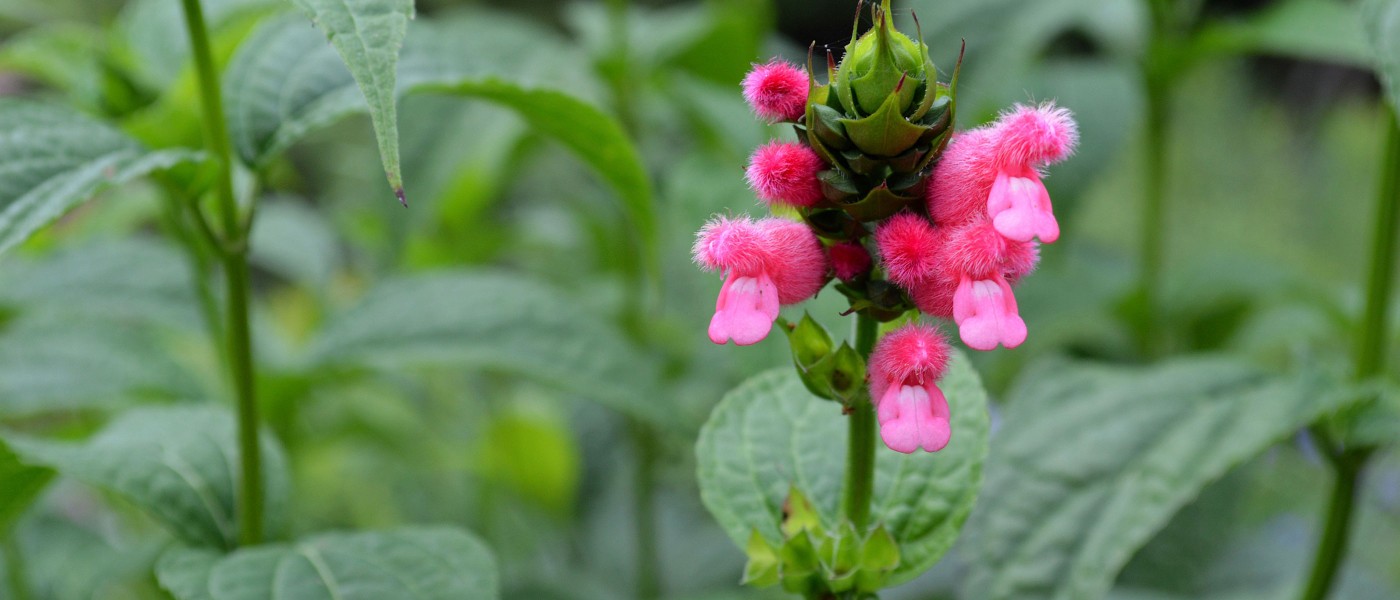A Garden for Hummingbirds
This year, there is a special place in the Discovery Garden with containers specifically planted for the ruby-throated hummingbird, the smallest bird in New York. In the Hummingbird Garden you’ll find plants with various attributes that attract hummingbirds, from bright red colors to tubular-shaped flowers.
A fascinating aspect of the relationship between hummingbirds and these plants is the way they have coevolved. Hummingbirds have an incredible ability to hover in place and precisely aim their beaks into the center of a flower to extract nectar. These plants have adapted to produce nectar with a high sugar content—exactly what hummingbirds, important pollinators, need for energy.
Curated by gardener Jenny Blackwell, many of these annuals were grown from seed right here at Brooklyn Botanic Garden, and some were sourced from nurseries. Most of these plants have a long flowering duration, blooming from late spring through fall. Try planting some of these hummingbird favorites in your own containers or window boxes at home.
Anatomy of a Hummingbird Flower
- Blooms tend to be red or orange, sometimes pink.
- They are typically long and tubular, adapted for a hummingbird’s long, narrow bill and tongue.
- Unlike insect-pollinated flowers, blossoms usually are not fragrant, because hummingbirds, like most birds, have a poor sense of smell.
- They provide plenty of nectar. Sugar content averages about 26 percent—about double the amount in a soft drink.
- The flowers often point downward so that hovering hummingbirds have easy access.
- They have long stamens (the male flower parts that hold the pollen-bearing anthers) so that pollen can be distributed on the visiting bird’s forehead.
Plants for Hummingbirds
Mexican Sunflower
Tithonia rotundifolia
Native to Mexico and Central America, the Mexican sunflower is a member of the Asteraceae, or aster family. Bright red-orange petals, or ray flowers, surround a center of clustered florets (or disc flowers). The nectar-rich Mexican sunflower can grow quite tall, between four to six feet in height, and attracts bees and butterflies as well as hummingbirds.
Bolivian Hummingbird Sage
Salvia oxyphora
Fuzzy, trumpet-shaped flowers adorn this hummingbird sage, which is native to rocky landscapes of the Bolivian Andes on the border of Peru. Bees are drawn to Bolivian hummingbird sage as well.
Petunia exserta
The Petunia exserta, native to Brazil, is the only species of petunia that is naturally pollinated by hummingbirds in the wild. Long, tubular red flowers adorn this plant, which is a member of the Solanaceae, or nightshade family.
Wild Bergamot
Monarda fistulosa
This native herbaceous perennial is a member of the Lamiaceae, or mint family. Clusters of light purple, tubular flowers form flower heads reminiscent of the shape of a crown. Its foliage is fragrant, making wild bergamot a popular essential oil as well as a tea.
Snapdragon Vine
Maurandella antirrhiniflora
This fast-climbing herbaceous vine is native to Mexico and Central America. In addition to hummingbirds, its funnel-shaped flowers also attract butterflies.
Fuchsia ‘Annabel’
Fuchsia ‘Annabel’ boasts pendant, bell-shaped flowers with long, light-pink stamens that extend beyond the petals. Blooming from summer through fall, this fuchsia is a member of the Onagraceae, or evening primrose family. Butterflies and bees are also attracted to this annual.
Baby sage
Salvia microphylla ‘San Carlos Festival’
Native to the mountains of Mexico, this sage was first introduced from the village of San Carlos. Its magenta-pink, trumpet-shaped flowers also attract bees.
Be sure to check out For the Birds, a multidisciplinary exhibition and program series inspired by the Garden’s resident birds, as well as “For the Birds: The Birdsong Project,” a multialbum set of original recordings celebrating birds by 200-plus artists, compiled by Randall Poster. Join in on birding tours and events and explore our other bird-themed gardens. Find more information at bbg.org/forthebirds.










